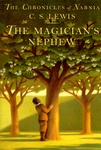Chronicles of Narnia--What Order?

reported by Holly Hartman |
In 1957 an American boy wrote C. S. Lewis to ask about the best order for reading The Chronicles of Narnia. The boy's mother believed the books should be read in order of their publication, beginning with The Lion, the Witch and the Wardrobe. But the boy thought it would be better to read them in order of Narnian history, beginning with the creation of the enchanted world in The Magician's Nephew. C. S. Lewis wrote back to the boy, saying, "I think I agree with your order for reading the books more than with your mother's," and soon afterward the publishers began to number them in this way. But Lewis, who had written bits and pieces of the books at different times, also noted that the order probably didn't much matter: "I'm not even sure that all the [books] were written in the same order in which they were published." Below, the books are listed in the order of Narnian history, accompanied by the first line of each. If you prefer to read them in the original order—an order that may bring more surprises—follow the dates after the titles instead. |
 The Magician's Nephew (1955) The Magician's Nephew (1955)"This is a story about something that happened long ago when your grandfather was a child." Two children stumble into a bizarre experiment and are transported across time and space. They witness the dawn of a world, where new plants and animals are called by their creator to "Be walking trees. Be talking beasts." |
 The Lion, the Witch and the Wardrobe (1950)
The Lion, the Witch and the Wardrobe (1950)
"Once there were four children whose names were Peter, Susan, Edmund and Lucy."
During World War II four siblings, Peter, Susan, Edmund, and Lucy, are sent to live in the country home of an elderly professor. Among the mysteries of the house is an old wardrobe that yields a passage to an extraordinary land.
 The Horse and His Boy (1954) The Horse and His Boy (1954)"This is the story of an adventure that happened in Narnia and Calormen and the lands between, in the Golden Age when Peter was High King in Narnia and his brother and his two sisters were Kings and Queens under him." Talking horses use their wits on a quest to guide two refugee children to safety. This journey story—a favorite of many young Lewis fans—is the only Chronicle to take place entirely in the world of Narnia and its neighbors. |
 Prince Caspian (1951)
Prince Caspian (1951)
"Once there were four children whose names were Peter, Susan, Edmund, and Lucy, and it has been told in another book called The Lion, the Witch and the Wardrobe how they had a remarkable adventure."
A year after first entering the wardrobe, Peter, Susan, Edmund and Lucy return to Narnia, where the passage of centuries has brought hostile invaders. The Earth children join forces with outlaw Prince Caspian and his animal followers to save their beloved land.
 The Voyage of the Dawn Treader (1952) The Voyage of the Dawn Treader (1952)"There was a boy called Eustace Clarence Scrubb, and he almost deserved it." Edmund, Lucy, and their spoilsport cousin Eustace are called to a mission on the seas of Narnia. The islands that lie beyond the kingdom offer mystery and wonder—and in a world that is flat, what lies where the sea ends may be the greatest wonder of all. |
 The Silver Chair (1953)
The Silver Chair (1953)
"It was a dull autumn day and Jill Pole was crying behind the gym."
Fleeing schoolyard bullies, a much-improved Eustace and his friend Jill slip through the school walls and into another world. Armed only with four puzzling clues, they travel in kingdoms both above and beneath the ground to rescue a captive Narnian prince.
 The Last Battle (1956) The Last Battle (1956)"In the last days of Narnia, far up to the west beyond Lantern Waste and close beside the great waterfall, there lived an Ape." A fluke event on the British Railways permits Eustace, Jill, and other Friends of Narnia to return to that kingdom at its hour of greatest crisis. When an Ape's deceit leads to chaos, competing forces battle for Narnia's survival. |
